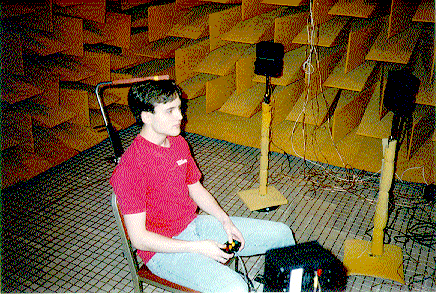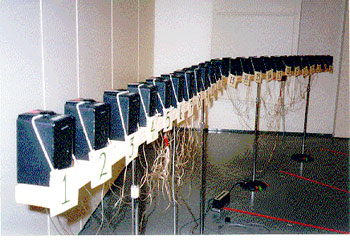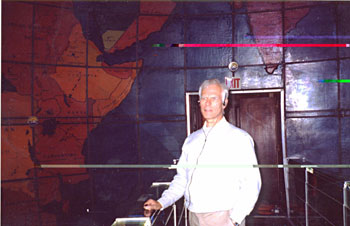
Tim running a precedence effect experiment in the anechoic room
LOCALIZATION OF SOUND SOURCES
Human listeners are able to localize the sources of sound with good accuracy over almost all of the 4 pi radians of angular space. Traditionally, the psychoacoustical study of localization has emphasized the way that listeners use the differences in signal intensity at the two ears and the differences in signal arrival time at the two ears to localize sources. However, listeners are also capable of localizing sources in a vertical plane for which interaural differences are theoretically zero. More than that, listeners are capable of localizing sources in rooms where the acoustical reflections from the walls (coming in from random angles) have greater power than the sound directly from the source. The ability to cope with reflections of this kind is known as the "Precedence Effect." Our recent study of sound localization has emphasized vertical plane localization and the precedence effect, both individually and in combination. In recent experiments we have begun to study "externalization," the fact that listeners perceive sounds to be located out in the environment ... not within their own heads.

Tim running a precedence effect experiment in the anechoic room
Our localization experiments are done in the Rooms Lab in the Communication Arts Building on the Michigan State University campus. The rooms lab includes a recently built IAC anechoic room with one-meter foam wedges on all six surfaces as well as a large reverberation room with a reverberation time of 4 seconds at mid frequencies.
References
"Some psychoacoustical experiments with all-pass networks," W.M. Hartmann, Am. J. Phys. {47}, 29-34 (1979).
"Localization of sound in rooms," W.M. Hartmann, J. Acoust. Soc. Am. {74}, 1380-1391 (1983).
"Localization of sound in rooms II: The effect of a single reflecting surface," B. Rakerd and W.M. Hartmann, J. Acoust. Soc. Am. {78}, 524-533 (1985).
"Localization of sound in rooms III: Onset and duration effects," B. Rakerd and W.M. Hartmann, J. Acoust. Soc. Am. {80}, 1695-1706 (1986).
"On the minimum audible angle - A decision theory approach," W.M. Hartmann and B. Rakerd, J. Acoust. Soc. Am. {85}, 2031-2041 (1989).
"Localization of sound in rooms IV - The Franssen effect," W.M. Hartmann and B. Rakerd, J. Acoust. Soc. Am. {86}, 1366-1373 (1989).
"Auditory spectral discrimination and the localization of clicks in the sagittal plane," W.M. Hartmann and B. Rakerd, J. Acoust. Soc. Am. {94}, 2083-2092 (1993).
"On the externalization of sound images," W.M. Hartmann and A.T. Wittenberg, J. Acoust. Soc. Am. {99}, 3678-3688 (1996).
"Psychophysical and physiological evidence for a precedence effect in the median sagittal plane,"R.Y. Litovsky, B. Rakerd, T.C.T. Yin, and W.M. Hartmann, J. Neurophysiology, {77} 2223-2226 (1997).
"On the source identification method," W.M. Hartmann, B. Rakerd, and J.B.Gaalaas, J. Acoust. Soc. Am. {104}, 3546-3557 (1998).
"Sound localization in the median sagittal plane by elderly listeners," B. Rakerd, T. VanderVelde, and W.M. Hartmann, J. Am. Acad. Audiol. {9}, 466-479 (1998).

The V24
array in the reverberation room has 24 loudspeakers. One of them is caused to
emit a sound. The listener is 6 meters away and has the task of deciding which
speaker is active.
"Binaural coherence and the localization of sound in rooms," W.M. Hartmann, Z.A. Constan, and B. Rakerd, Proceedings of the 16th International Congress on Acoustics, Acoust. Soc. of Am. pp 2889-2890 (1998)
"Identification and localization of sound sources in the median sagittal plane," B.Rakerd, W.M. Hartmann, and T.L.McCaskey, J. Acoust. Soc. Am. {106}, 2812-2820 (1999).
"Echo suppression in the horizontal and median sagittal planes," B. Rakerd, W.M. Hartmann, and J. Hsu, J. Acoust. Soc. Am., {107}, 1061-1064, (2000).
"Interaural level differences and the level-meter model," W.M. Hartmann and Z.A. Constan, J. Acoust. Soc. Am. {112} 1037-1045 (2002).
"On the detection of dispersion in the head-related transfer function," Z.A. Constan and W.M. Hartmann, J. Acoust. Soc. Am. {114}, 998-1008 (2003).
"Binaural coherence in rooms," W.M. Hartmann, B. Rakerd, and A. Koller, Acta Acustica {91}, 451-462 (2005).
"The role of reverberation in release from masking due to spatial separation of sources for speech identification," G. Kidd, C.R. Mason, A. Brughera, and W.M. Hartmann, Acta Acustica, {114}, 526-536 (2005).
"Interaural fluctuations and the detection of interaural incoherence: Bandwidth effects," M.J. Goupell and W.M. Hartmann, J. Acoust. Soc. Am. {119}, 3971-3986 (2006).
"Interaural fluctuations and the detection of interaural incoherence II: Brief duration noises," M.J. Goupell and W.M. Hartmann, J. Acoust. Soc. Am. {121}, 2127-2136 (2007).
"Interaural fluctuations and the detection of interaural incoherence III: Narrowband experiments and binaural models," M.J. Goupell and W.M. Hartmann, J. Acoust. Soc. Am. {122}, 1029-1045 (2007).
"Lateralization of sine tones - Interaural time vs phase," P.X. Zhang and W.M. Hartmann, J. Acoust. Soc. Am. {120}, 3471-3474 (2006).
"Lateralization of Huggins pitch," P.X. Zhang and W.M. Hartmann, J. Acoust. Soc. Am. {124}, 3873-3887 (2008).
"The acoustical bright spot and the mislocalization of tones by human listeners," E.J. Macaulay, W.M. Hartmann, and B. Rakerd, J. Acoust. Soc. Am. {127}, 1440-1449 (2010).
"Interaural coherence for noise bands: Waveforms and envelopes," N.L. Aaronson and W.M. Hartmann, J. Acoust. Soc. Am. {127}, 1367-1372 (2010).
"Phase effects on the perceived elevation of complex tones," W.M. Hartmann, V. Best, J. Leung, S. Carlile, J. Acoust. Soc. Am. {127}, 3060-3072 (2010).
"Localization of sound in rooms. V. Binaural coherence and human sensitivity to interaural time differences in noise" B. Rakerd and W.M. Hartmann, J. Acoust. Soc. Am. {128}, 3052-3063 (2010).
"On the ability of human listeners to distinguish between front and back<" P.X. Zhang and W.M. Hartmann Hearing Research {260}, 30-46 (2010).
"Generating partially coherent noise -- A comparison of methods" W.M. Hartmann, and Y.J. Cho, J. Acoust. Soc. Am. {130}, 292-301 (2011).
"Human interaural time difference thresholds for sine tones: The high-frequency limit" A. Brughera, L. Dunai, and W.M. Hartmann. J. Acoust. Soc. Am. {133}, 2839-2855 (2013).
"Testing, correcting, and extending the Woodworth model for interaural time differences," N.L. Aaronson and W.M. Hartmann. J. Acoust. Soc. Am. {135}, 817-823 (2014).
"Anatomical limits on interaural time differences: an ecological perspective," W.M. Hartmann and E.J. Macaulay, Frontiers in Neuroscience, {8}, doi: 10.3389fnins.2014.00034 (2014).
"Computing interaural differences through finite element modeling of idealized human heads," T. Cai, B. Rakerd, and W.M. Hartmann J. Acoust. Soc. Am. {138}, 1549-1560 (2015).
"Transaural experiments and a revised duplex theory for the localization of low-frequency tones," W.M. Hartmann, B. Rakerd, Z.D. Crawford, and P.X. Zhang J. Acoust. Soc. Am. {139}, 968-985 (2016).
"On the localization of high-frequency, sinusoidally amplitude-modulated tones in free field," E.J. Macaulay, B. Rakerd, T.J. Andrews, and W.M. Hartmann J. Acoust. Soc. Am. {141}, 847-863 (2017).
Further References

Boston's Mapparium is a 30-foot glass sphere with a glass
bridge across a diameter. The acoustical properties of this environment are
highly unusual and lead to surprising illusions in sound localization. Together
with colleagues from Boston University, we are attempting to explain the
illusions in terms of the acoustics of this space.
In this picture, the experimenter is wearing binaural microphones connected to a digital recorder to capture the sound field at the two ears.
"Localization of sound in rooms, the effect of visual fixation," W.M.Hartmann, {Proceedings 11th ICA}, (Journal d'Acoustique) {3}, 139-142 (1983).
"Localization of a source of sound in a room," W.M. Hartmann, Proc. Audio Engr. Soc. Eighth International Conference, ed. S. Pizzi, pp 27-32, AES, New York (1990).
"Auditory Localization in rooms," W.M. Hartmann, Proc. Audio Engr. Soc. Twelfth International Conference, ed. S. Bech pp 34-39, AES, New York (1993).
"Listening in a Room and the Precedence Effect," W.M. Hartmann, in {Binaural and Spatial Hearing} ed. R.H. Gilkey and T.B. Anderson, pp 191-210, L. Erlbaum Associates (1997).
"Head-related transfer functions," W.M. Hartmann, {Echoes}, {8}, No. 2, spring 1998.
"How we localize sound," W.M. Hartmann, Physics Today, November, 1999 pp 24-29.
"How we localize sound," November 2000, (translation) Japanese selections from Physics Today.
"Simulating the Franssen Illusion," W.M. Hartmann and S.R. Lawton, {\it 17th ICA} 3C15.03, Rome, (2001).
"Localization of noise in a reverberant environment," B. Rakerd and W.M. Hartmann, Proceedings of the 13th International Symposium on Hearing, Dourdon, France, 2003.